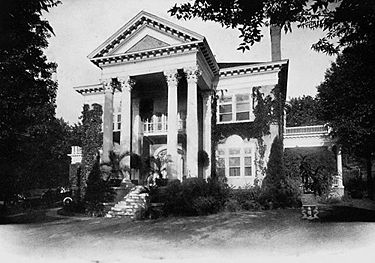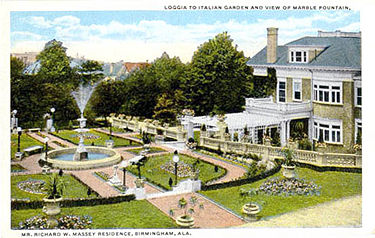Richard Massey residence: Difference between revisions
(New page: The '''Joseph Turner residence''' was a Greek-revival style mansion located at 1401 Beech Street (21st Way South) on the southeast corner of Simmons Avenue ([[13th Street South...) |
No edit summary |
||
| (8 intermediate revisions by 2 users not shown) | |||
| Line 1: | Line 1: | ||
The ''' | [[Image:Massey residence.jpg|right|thumb|375px|Richard Massey residence in 1910]] | ||
The '''Richard Massey residence''' was a Greek-revival style mansion located at 1401 [[Beech Street]] ([[21st Way South]]) on the southeast corner of [[Simmons Avenue]] ([[13th Avenue South]]). It was designed and constructed as a showpiece home by architect [[Joseph Turner|Joseph Clifford Turner]] in [[1904]], but never occupied by him. | |||
The 20-room mansion featured a circular entrance hall with a marble fountain at the center. A circular stair gave access to the second-floor bedrooms while the top of the rotunda had a stained-glass dome which was illuminated at night. Each room, including the bedrooms, had a fireplace with a unique, hand-carved mantelpiece and a crystal chandelier. | The 20-room mansion featured a circular entrance hall with a marble fountain at the center. A circular stair gave access to the second-floor bedrooms while the top of the rotunda had a stained-glass dome which was illuminated at night. Each room, including the bedrooms, had a fireplace with a unique, hand-carved mantelpiece and a crystal chandelier. | ||
| Line 5: | Line 6: | ||
On [[February 1]], [[1904]], after the birth of their sixth child, Turner's wife died from pneumonia, having refused medical treatment due to her Christian Scientist faith. Turner sold the house to [[Richard Massey]], founder of [[Massey Business College]]. He was able to negotiate a good price and bought it without consulting his wife, who had wanted to build a home on then-fashionable [[5th Avenue North]] rather than "out in the country". She later came to appreciate her husband's foresight. The Masseys named the house '''Turner''', and claimed that Flora's ghost haunted the upper gallery. | On [[February 1]], [[1904]], after the birth of their sixth child, Turner's wife died from pneumonia, having refused medical treatment due to her Christian Scientist faith. Turner sold the house to [[Richard Massey]], founder of [[Massey Business College]]. He was able to negotiate a good price and bought it without consulting his wife, who had wanted to build a home on then-fashionable [[5th Avenue North]] rather than "out in the country". She later came to appreciate her husband's foresight. The Masseys named the house '''Turner''', and claimed that Flora's ghost haunted the upper gallery. | ||
Massey brought an Italian gardener to design and oversee the maintenance of an elaborate terraced garden in the rear of the house. Through leaded-glass doors from the hall or music room, onto a wisteria-draped terrace, the garden was filled with aromatic plants and imported statuary. The manicured landscape served as setting for innumerable parties and dances, and was recognized as one of the city's loveliest spots, a favorite scene for postcard publishers. | [[Image:Massey residence garden postcard.jpg|left|thumb|375px|Massey's Italian-inspired gardens]] | ||
Massey brought an Italian gardener to design and oversee the maintenance of an elaborate terraced garden in the rear of the house. Through leaded-glass doors from the hall or music room, onto a wisteria-draped terrace, the garden was filled with aromatic plants and imported statuary. A broad terrace was surrounded by a seat-height wall and anchored by a large marble fountain. The manicured landscape served as setting for innumerable parties and dances, and was recognized as one of the city's loveliest spots, a favorite scene for postcard publishers. | |||
As president of the [[Birmingham Chamber of Commerce]], Massey hosted President William Howard Taft at the house during his [[1909 presidential visit|1909 tour]]. It was the home of Massey's five children, notably [[Elizabeth McCoy|Elizabeth]], a musician, and [[Eleanor Bridges|Eleanor]], a painter, who were both married in the parlor. It was the birthplace of [[Richardine Massey|Richardine]] and [[Richard Massey, Jr]]. | As president of the [[Birmingham Chamber of Commerce]], Massey hosted President William Howard Taft at the house during his [[1909 presidential visit|1909 tour]]. It was the home of Massey's five children, notably [[Elizabeth McCoy|Elizabeth]], a musician, and [[Eleanor Bridges|Eleanor]], a painter, who were both married in the parlor. It was the birthplace of [[Richardine Massey|Richardine]] and [[Richard Massey, Jr]]. | ||
It was sold | It was sold after the Massey's children were grown and became the home of the [[Birmingham College of Music]] for a time. Later it served as the residence of Dr and Mrs [[James Crenshaw]]. The house was demolished in the 1960s for the construction of the [[Elton B. Stephens Expressway]]. | ||
==References== | ==References== | ||
| Line 15: | Line 17: | ||
* Rittenhouse, Berdine L. (January 21, 1980) "[http://oh.mhsl.uab.edu/emb/ A Memoir: Eleanor Massey Bridges, Feminist: Life in a Segregated Society]" oral history interview. UAB. | * Rittenhouse, Berdine L. (January 21, 1980) "[http://oh.mhsl.uab.edu/emb/ A Memoir: Eleanor Massey Bridges, Feminist: Life in a Segregated Society]" oral history interview. UAB. | ||
* {{Adams-2002}} | * {{Adams-2002}} | ||
==External links== | |||
* [http://www.atwalker.com/pcb/resident/masseyhouse.html Massey House] at [[Postcard Birmingham]] | |||
{{DEFAULTSORT:Massey residence}} | |||
[[Category:Birmingham houses]] | |||
[[Category:Joseph Turner buildings]] | |||
[[Category:1904 buildings]] | |||
[[Category:21st Way South]] | |||
[[Category:1960s demolitions]] | |||
[[Category:Haunts]] | |||
Latest revision as of 10:14, 7 April 2021
The Richard Massey residence was a Greek-revival style mansion located at 1401 Beech Street (21st Way South) on the southeast corner of Simmons Avenue (13th Avenue South). It was designed and constructed as a showpiece home by architect Joseph Clifford Turner in 1904, but never occupied by him.
The 20-room mansion featured a circular entrance hall with a marble fountain at the center. A circular stair gave access to the second-floor bedrooms while the top of the rotunda had a stained-glass dome which was illuminated at night. Each room, including the bedrooms, had a fireplace with a unique, hand-carved mantelpiece and a crystal chandelier.
On February 1, 1904, after the birth of their sixth child, Turner's wife died from pneumonia, having refused medical treatment due to her Christian Scientist faith. Turner sold the house to Richard Massey, founder of Massey Business College. He was able to negotiate a good price and bought it without consulting his wife, who had wanted to build a home on then-fashionable 5th Avenue North rather than "out in the country". She later came to appreciate her husband's foresight. The Masseys named the house Turner, and claimed that Flora's ghost haunted the upper gallery.
Massey brought an Italian gardener to design and oversee the maintenance of an elaborate terraced garden in the rear of the house. Through leaded-glass doors from the hall or music room, onto a wisteria-draped terrace, the garden was filled with aromatic plants and imported statuary. A broad terrace was surrounded by a seat-height wall and anchored by a large marble fountain. The manicured landscape served as setting for innumerable parties and dances, and was recognized as one of the city's loveliest spots, a favorite scene for postcard publishers.
As president of the Birmingham Chamber of Commerce, Massey hosted President William Howard Taft at the house during his 1909 tour. It was the home of Massey's five children, notably Elizabeth, a musician, and Eleanor, a painter, who were both married in the parlor. It was the birthplace of Richardine and Richard Massey, Jr.
It was sold after the Massey's children were grown and became the home of the Birmingham College of Music for a time. Later it served as the residence of Dr and Mrs James Crenshaw. The house was demolished in the 1960s for the construction of the Elton B. Stephens Expressway.
References
- Lackey, Orlean (November 25, 1962) "Expressway will sweep through city's first Italian garden." Birmingham News
- Rittenhouse, Berdine L. (January 21, 1980) "A Memoir: Eleanor Massey Bridges, Feminist: Life in a Segregated Society" oral history interview. UAB.
- Adams, Cathy Criss (2002) Worthy of Remembrance: A History of Redmont. Birmingham: Redmont Park Historic District Foundation ISBN 0971784000

